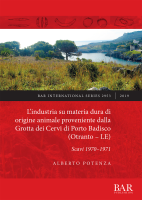Description
Grotta dei Cervi di Porto Badisco venne scoperta nel 1970 dal Gruppo Speleologico “De Lorentiis”. Lo stesso anno iniziarono gli scavi dell’allora Soprintendente Felice Gino Lo Porto, che in due successive campagne, 1970 e 1971, indagò quelli che oggi sono conosciuti come “Ingresso Est” e “Ingresso Ovest”. Grotta dei Cervi fu un santuario di richiamo internazionale per tutto il Neolitico e l’età dei Metalli. La frequentazione della Grotta fu continuativa dagli inizi del VI sino alla fine del II millennio a. C. La presenza di manufatti particolari testimonia contatti con regioni distanti, che vanno dall’area tirrenica ligure alle zone del Mediterraneo orientale e che rimandano a un patrimonio simbolico comune. In questo lavoro si presentano i dati emersi dallo studio dei manufatti ottenuti su materia dura animale, provenienti dagli scavi 1970-1971. Oggetti di vita quotidiana e oggetti di culto che permettono di avere un quadro più ampio delle antiche civiltà.Grotta dei Cervi was discovered in 1970 by the Speleological Group “De Lorentiis”.
The first investigations date back to 1970 and 1971 and were carried out by the then Superintendent to the Antiquities F. G. Lo Porto. He excavated the eastern and western cavities. Grotta dei Cervi represented an important sanctuary during the Neolithic and the Bronze Age. The cave was uninterruptedly frequented from the beginning of the 6th millennium to the end of the 2nd millennium BC. The occurrence of exotic material testifies to relationships with distant countries, among them the Tyrrhenian coast of Liguria and the eastern Mediterranean area, suggesting the use of a common symbolic heritage. In this book the study of bone tools found during the 1970-71 excavations is presented. They represent daily life and cultural objects that allow us to have a broader picture of ancient civilisations.
AUTHOR
Alberto Potenza è uno specialista in Archeozoologia, laureato e specializzato presso l’Università del Salento. Le sue ricerche riguardano lo studio di resti animali rinvenuti in contesti preistorici, con particolare attenzione nei confronti dell’industria su materia dura di origine animale. Attualmente collabora con diverse missioni archeologiche nazionali e internazionali (Turchia, Grecia, Egitto, Iran). E’ inoltre specializzato nel disegno degli artefatti archeologici.
Alberto Potenza is a specialist in Zooarchaeology, with a post-graduate school of specialization degree carried out at the University of Salento (Lecce, Italy). His research interest includes the study of animal remains from Prehistoric contexts, with particularly attention to animal bone tools. He currently collaborates with several national and international archaeological missions (Turkey, Greece, Egypt, Iran). He is also a specialist in drawing archaeological artifacts.
REVIEW
‘Despite the importance of the site, this is the first and only comprehensive study of the worked bone […]. It is certainly of great value to the research community.’ Prof. Umberto Albarella, University of Sheffield











